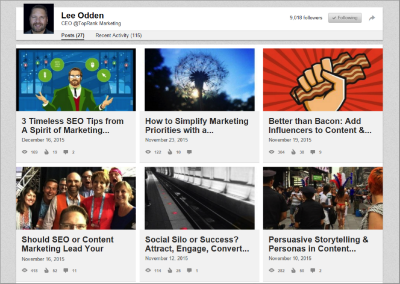For many marketers, “long-form content” often refers to creating an eBook, drafting a 1,500-word blog post or developing a white paper—certainly not a concept associated with shorter-the-better social media posts. Well, that’s definitely changing.
As the digital space gets more cluttered, marketers are embracing new ways to stand out from competitors and engage with their audience. And publishing long-form content on social media is one content marketing tactic they’re taking advantage of.
According to Statista, it’s estimated that there will be around 2.13 billion social network users worldwide in 2016, up from 1.4 billion in 2012. With so many people engaged on social media, long-form posts can allow you to meet your audience on their turf, while furthering your own social media presence and promoting your brand.
Definition of Long-Form Content on Social Media
Generally speaking, long-form content on social media is content that contains more characters than traditional social media posts, and is meant to inform readers like a blog or news article. With that said, each social media platform handles long-form content differently:
- Some platforms offer a specific publishing platform or app that allows users to post longer, editorialized posts that are linked to their social media profiles. (e.g. LinkedIn Publisher and Facebook Notes)
- Other platforms allow for more characters to be used in status updates. (e.g. Instagram, Google+ and Twitter in the near future.)
As a content marketing tactic, long-form content on social media can be used to build brand awareness and thought leadership, while also driving traffic back to a company’s website and contributing to SEO priorities.
Status Updates vs. Long-Form Posts
Usually status updates are limited to a certain number of characters and there are no real publishing features to speak of. On platforms such as LinkedIn, long-form content can include hyperlinks, formatting options, photos and videos, and sometimes presentations or other supporting documents.
Pros of Long-Form Content
Social media marketing is an important element of any integrated content marketing strategy. Long-form posts allow brands more opportunity to reach their followers and expand their online presence. Here are some other benefits of long-form content posts on social media:
- Your content is delivered to an already captive audience—your followers.
- With so many people using social media on a daily—and even hourly—basis, your content can reach new audiences.
- Individuals can use their expertise and knowledge to create content that not only allows them to promote their company, but position themselves as industry influencers, too.
- Some platforms provide impression and demographic data so you can measure success and see who is reading you content.
- Businesses can add a new content creation space, without adding another platform to maintain.
Cons of Long-Form Content
While long-form posts offer many benefits, there are also some disadvantages:
- For LinkedIn specifically, companies are unable to publish content using their organization’s name or publish from their Company Page.
- The open nature of social media allows anybody to create content, which means bad content from others could bog down your quality content.
- While you’re able to leverage your existing audience with your posts, there’s really no guarantee your content will be read.
- Since your website or blog isn’t hosting the material, you don’t really “own” that content.
- You could lose all the content you produce when or if these platforms go away.
What Experts are Saying
“A seemingly endless debate in the business world is short-form versus long-form content. Do we acknowledge the research that shows that long-form content is shared more or do we respect busy readers who have limited time and attention span? Here is another view: The story should determine the length. The length doesn’t determine the story! People from every generation still consume long-form content if the content is interesting and compelling. Don’t make the story conform to algorithmic standards. Let the story dictate the proper length. Instead of long-form or short-form, maybe we should aim for ‘right-form’ content.”
Mark W. Schaefer, Executive Director of Schaefer Marketing Solutions
“For businesses, the [Facebook Notes] upgrade is particularly interesting. Notes is an optional app add-on for Pages, and, theoretically, any upgrade to Notes will also flow through to Pages as well. That being the case, this is a whole new option for businesses to share their content and reach their audience.”
Andrew Hutchinson, social media consultant, author and contributor to Social Media Today. (Source: socialmediatoday.com)
“LinkedIn publishing opened the door to others like Facebook, which recently brought back their Notes long-form content functionality. At the same time, the spirit of using Flickr for blogging is now emerging on Instagram. I’m no fan of homesteading on rented land, but having a presence on social networks with long-form content keeps readers where they want to be instead sending them away with a click, only to close the window anyway.”
Lee Odden, CEO of TopRank Marketing
Examples of Long-Form Content on Social Media
National Geographic

National Geographic is known for capturing iconic and breath-taking photos around the world. So of course the publication uses Instagram to its fullest potential—often times with mini-news stories complete with the who, what, where, when, why and how, according to Business2Community.
Author & Entrepreneur Ed “Skip” McLaughlin

McLaughlin has been regularly publishing content on LinkedIn since 2014. His posts focus on business tips and trends for startups—and it turns out he’s in the process of co-writing a book on that very subject. Through his posts McLaughlin is able to illustrate his startup knowledge and expertise while building thought leadership and buzz for his upcoming book.
Lee Odden

TopRank Marketing co-founder Lee Odden’s regular long-form posts on LinkedIn not only allow him to share his expertise, but also promote his company’s brand.
Best Practices
- Write what you know. Your expertise and knowledge are valuable to your social media community. Writing what you know will not only lend credibility to you and your company, but also provide solid, trustworthy information users can count on.
- Stick to one topic. Trying to cover too many things will likely not provide all the important information your users want on a specific topic. (Tip: Take some time to list all your post ideas and brainstorm headlines for each to focus the topics. Once you have your concept headlines, outline each of the posts so you know what you should cover.)
- Be visual. Include photos, videos or slideshare presentations where you can.
- Remember SEO best practices. SEO basics are important because some platforms allow your content to be found in searches.
- Treat posts as an extension of your blog. Long-form posts on social media provide companies with another way to reach audiences through quality content. Your posts should be useful, informative and provide the best possible answer to readers’ questions.
Helpful Resources
Here are a few helpful articles that will give you a taste of posting long-form content on various social media platforms:
- The Art of Long Captions for Instagram (Crowdfire)
- Tips for Writing Long-Form Posts on LinkedIn (LinkedIn)
- The Art of Writing Great Google+ Posts (Copyblogger)
- Distribution of Long-Form Posts on LinkedIn (Linkedin)
- FAQ: Facebook Notes (Facebook)
And as always, check out the TopRank Marketing blog for more content marketing tips and tricks.
Using social media platforms to post long-form content can be a valuable tool in a company’s content marketing arsenal. Long-form posts allow you to further your presence on those platforms, connect with current and new customers, and further brand awareness. However, it’s important to remember that any content posted on these mediums could go away at any time. So, if you do decide to use long-form content as part of your content marketing strategy, use it as a way to support your efforts—not as a replacement.
Which social media platforms do you utilize for long-form posts? What has your experience been? Tell us in the comments section below.
Did you like this post? Then you should check out our content marketing tactics index page with links to over 25 helpful posts just like this one!
Header image via Shutterstock



